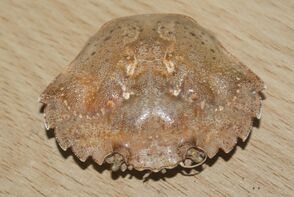
Shore Crab - WWC Archives
The Shore Crab (Carcinus maenas) is common through out the UK. They eat carrion and live prey. It uses it claws to crack mussel shells. It can weigh up to 150 grams. They are aggresive and often fight with their own kind and other crustaceans.
Description[]
C. maenas has a carapace up to 60 millimetres (2.4 in) long and 90 mm (3.5 in) wide, with five short teeth along the rim behind each eye, and three undulations between the eyes.
The colour of C. maenas varies greatly, from green to brown, grey or red. This variation has a genetic component, but is largely due to local environmental factors. In particular, individuals which delay moulting become red–coloured rather than green. Red individuals are stronger and more aggressive, but are less tolerant of environmental stresses, such as low salinity or hypoxia
Native and introduced range[]
C. maenas is native to European and North African coasts as far as the Baltic Sea in the east, and Iceland and central Norway in the north, and is one of the most common crabs throughout much of i

Shore Crab Carapace ~ WWC Archives
ts range.
Ecology[]
C. maenas can live in all types of protected and semi-protected marine and estuarine habitats, including habitats with mud, sand, or rock substrates, submerged aquatic vegetation, and emergent marsh, although soft bottoms are preferred. C. maenas is euryhaline, meaning that it can tolerate a wide range of salinities (from 4 to 52 %), and survive in temperatures of 0 to 30 °C. The wide salinity range allows C. maenas to survive in the lower salinities found in estuaries.
Females can produce up to 185,000 eggs, and larvae develop offshore in several stages before their final moult to juvenile crabs in the intertidal zone. Young crabs live among seaweeds and seagrasses such as Posidonia oceanica until they reach adulthood.
C. maenas is a predator feeding on many organisms, particularly bivalve molluscs (such as clams, oysters, and mussels), polychaetes and small crustaceans. They are primarily nocturnal, although activity also depends on the tide, and crabs can be active at any time of day.
Fishery[]
C. maenas is fished on a small scale in the north-east Atlantic Ocean, with approximately 1200 tonnes being caught annually, mostly in France and the United Kingdom. In the north-west Atlantic, C. maenas was the subject of fishery in the 1960s, and again since 1996, with up to 86 tonnes being caught annually.



